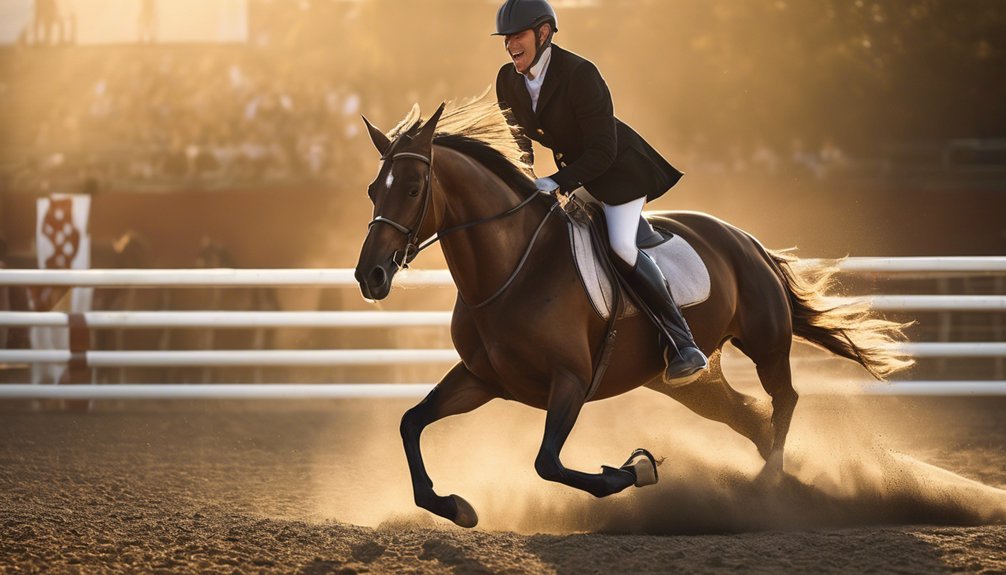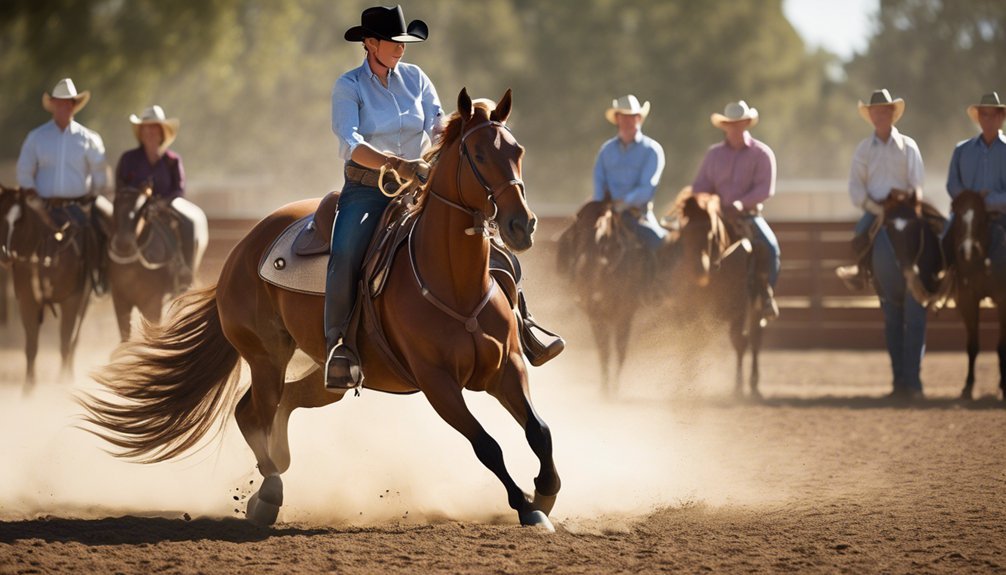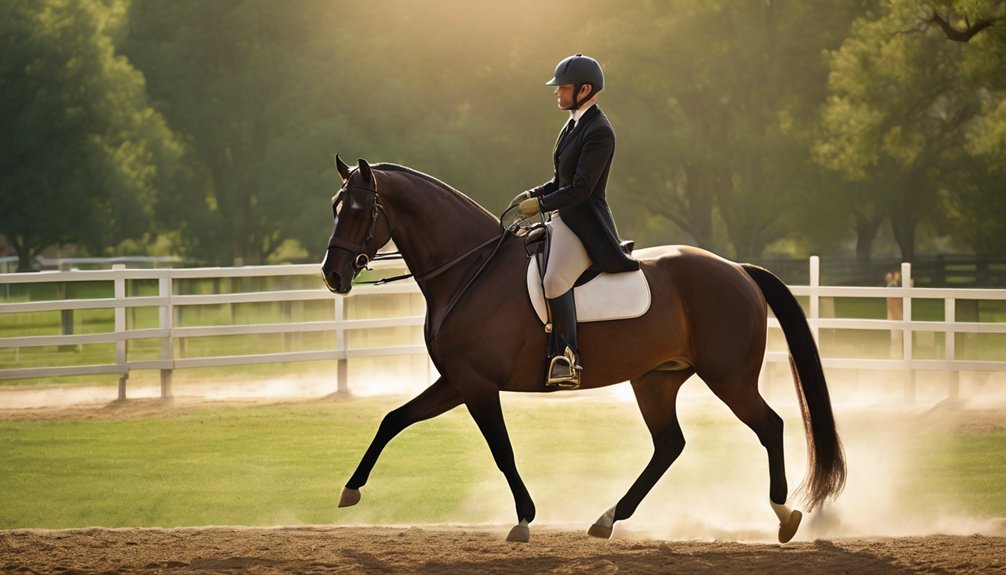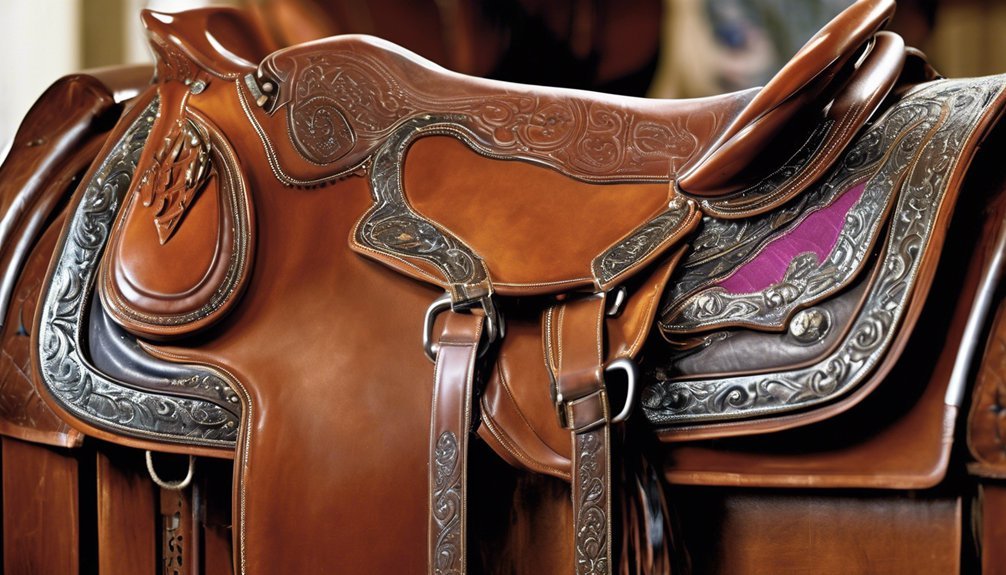
Improving your spins and stops in reining requires a solid understanding of the fundamentals and consistent practice. Engaging your horse's hindquarters is crucial for achieving balance and precision. Start with effective warm-up techniques to enhance flexibility. As you refine your skills, you'll want to focus on the appropriate use of rein and leg aids. This foundation will set you up for success as you explore key exercises that can elevate your performance. What's the next step in your training?
Key Takeaways
- Enhance your horse's hind end engagement through balance exercises to improve the quality of spins and stops.
- Use dynamic stretching during warm-ups to increase flexibility and prepare for performance.
- Practice consistent rein and leg aids to strengthen communication and ensure smooth transitions during spins and stops.
- Anticipate movements and maintain straight posture to provide effective stopping cues and improve overall control.
- Regularly practice in varied situations to build confidence and muscle memory for spins and stops.
Understanding the Basics of Spins and Stops

When you dive into the world of reining, understanding the fundamentals of spins and stops is crucial for elevating your performance.
Spin dynamics involve the horse's ability to pivot on its hindquarters, requiring a strong foundation in balance and rhythm. Focus on engaging your horse's hind end while maintaining a consistent tempo; this will enhance your spins significantly.
Stop mechanics, on the other hand, hinge on your horse's willingness to collect and prepare for a quick halt. By applying proper cues and timing, you can achieve a clean, powerful stop that impresses judges.
Mastering these elements not only boosts your skills but also fosters a deeper connection with your horse, creating a sense of belonging in the reining community.
Importance of Proper Warm-Up Techniques
Before you step into the arena, proper warm-up techniques play a vital role in preparing both you and your horse for optimal performance. Engaging in a structured warm-up can enhance your spins and stops significantly.
Focus on these key components:
- Dynamic stretching for your horse to increase flexibility and mobility.
- Gradual increases in intensity to ready both of you for the demands ahead.
- Groundwork to establish trust and communication.
- Mental preparation techniques, like visualization, to boost confidence.
- Hydration and nutrition checks to ensure peak condition.
Developing Balance and Control
To excel in reining, you must prioritize developing balance and control, as these elements are crucial for executing precise spins and stops.
Start by incorporating balance exercises into your routine, such as one-legged stands or riding with your eyes closed. These will enhance your core stability and connection with your horse.
Next, focus on control drills that challenge your ability to maintain a steady pace and direction. Practice transitions between gaits or figure eights to sharpen your responsiveness.
Utilizing the Correct Rein and Leg Aids

Mastering spins and stops in reining hinges on your ability to effectively utilize the correct rein and leg aids. The right combination of rein pressure and leg cues can significantly enhance your performance.
Here are key points to remember:
- Rein Pressure: Apply consistent pressure to guide your horse's movement.
- Inside Leg Cue: Use your inside leg to encourage your horse to pivot.
- Outside Leg Cue: Your outside leg should maintain forward motion while keeping the horse balanced.
- Timing: Coordinate your aids; timing is crucial for seamless execution.
- Practice: Regularly practice these aids to build muscle memory and strengthen communication with your horse.
Practicing Spins: Key Exercises to Enhance Technique
While honing your spinning technique, it's essential to incorporate specific exercises that reinforce both your horse's responsiveness and your own skill.
Start with spin drills, focusing on maintaining a consistent rhythm while encouraging your horse to pivot smoothly around its inside hind leg. Use a series of small, controlled spins to build confidence and precision.
Transition into pivot exercises, where you ask your horse to shift weight and turn on its haunches, enhancing balance and coordination.
Remember to maintain your body position; stay centered and relaxed.
Regularly practice these exercises, and you'll see improvement in your spins, strengthening the bond between you and your horse.
Embrace the process, and enjoy the journey together!
Mastering the Stop: Techniques for Precision
Building on the foundation of spins, mastering the stop is vital for achieving precision in reining.
To enhance your stopping technique, focus on these key aspects:
- Stop Timing: Anticipate your horse's movement and cue for the stop at the right moment.
- Body Alignment: Maintain a straight posture; your body should align with your horse for effective communication.
- Weight Distribution: Shift your weight back to encourage your horse to engage its hindquarters.
- Soft Hands: Use gentle pressure on the reins to signal the stop without forcing it.
- Practice Consistently: Regularly drill stops in various situations to build confidence and muscle memory.
Common Mistakes to Avoid

Even experienced riders can fall into common pitfalls that hinder their spins and stops in reining. To elevate your performance, be aware of timing issues and posture errors that can sabotage your progress. Here are some mistakes to avoid:
| Mistake | Impact |
|---|---|
| Poor timing | Leads to ineffective spins |
| Slouching posture | Reduces control and precision |
| Uneven weight shift | Affects balance and responsiveness |
| Rushed maneuvers | Causes mistakes in execution |
| Ignoring cues | Confuses your horse |
Building a Consistent Training Routine
Creating a consistent training routine is essential for enhancing your spins and stops in reining. A well-structured training schedule not only builds muscle memory but also fosters a sense of community among riders.
Here's how to establish an effective routine:
- Set specific goals for each training session.
- Incorporate varied exercises to keep your horse engaged.
- Dedicate time for both spins and stops during each session.
- Use progress tracking tools to monitor improvements.
- Schedule regular assessments to adjust your training methods.
Frequently Asked Questions
How Often Should I Practice Spins and Stops Each Week?
To optimize your progress, aim for at least three to four practice sessions weekly, balancing your training schedule. Consistent practice frequency will enhance your skills, build confidence, and foster a sense of community within your riding journey.
What Equipment Is Best for Training Spins and Stops?
For training spins and stops, ensure your saddle fit supports your balance. Choose the right bit for communication, use training aids like ground poles, and focus on horse conditioning to enhance performance effectively.
Can I Train Reining Alone or Do I Need a Partner?
Training reining's like learning to dance; you can go solo, but partner dynamics enhance the experience. While you can train alone, having a partner offers valuable feedback, motivation, and camaraderie, making progress more enjoyable.
What Age Should a Horse Start Learning Spins and Stops?
You should start teaching spins and stops to young horses around age three, ensuring they're physically and mentally ready. This training timeline helps build a solid foundation, fostering confidence and skill for their future in reining.
How Do I Know if My Horse Is Ready for Competition?
In today's competitive world, you'll know your horse is ready for competition by observing its behavior. Confident strides, calmness under pressure, and consistent performance indicate competition readiness. Trust your instincts and your horse's signals to guide you.
Conclusion
By honing your spins and stops, you're not just training your horse; you're crafting a partnership akin to a well-rehearsed dance. Embrace the journey of continuous improvement, remembering that even the finest athletes started as novices. Stay committed to your training routine, and avoid common pitfalls to unlock your horse's full potential. With patience and practice, you'll find that your efforts yield a performance as smooth and graceful as a whispered secret in the arena.





